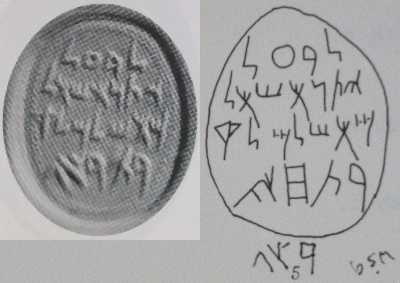I had hoped to meet Dr. Herr at some point during the conferences so I could show him a copy of his 1978 dissertation book I own, "The Scripts of Ancient Northwest Semitic Seals", which is the complimentary copy he originally gave to his professor, Frank Moore Cross, Jr. The dedicatory inscription in red ink reads, "Frank, Thanks for your help and support. It's your book as well as mine. Larry". Since now it's my book, I had hoped to get him to autograph p. 80, which contains the following entry in a list of "Formal & Semi-Formal Hebrew Seals":
11. lmlk Stamped Jar Handles--Last half of 7th c.
Inscriptions Reveal, nos. 80-90.
While he was signing it, I would've asked him if he still believed that date, & would've asked him to cross it out & correct it. But alas! Such an encounter was not to be.
And it wouldn't have been the first handwritten correction. While he owned it, Dr. Cross made several notes in black ink.
On the front end papers: "J. Naveh, BASOR 239 (1980)"
[As an interesting sidenote, P. Kyle McCarter, Jr. autographed my copy of BASOR 239 several years ago the first time I met him; it contains his analysis of "The Balaam Texts from Deir `Alla". It also contains "Paleography & the Identification of Seal Owners" by Larry G Herr. It's less than 3 pages long, but along with drawings & a paleography table describes 5 very important items: "The bulla of Berechiah the Son of Neriah the Scribe", "The Bulla of Jerahmeel the Son of the King", "The Seal of Seriah (the Son of) Neriah", "The Seal of Manasseh the Son of the King", & "The Seal of Jehoahaz the Son of the King". He treats them as authentic, & writes, "these inscriptions offer a convenient test of the paleographic dating procedures refined primarily by Frank M. Cross & supplemented by my paleographic treatment of the Northwest Semitic Iron Age seals (Herr 1978)." Cool!]
Seal #62 on p. 34: Herr's reading is "sm'b", but for some strange reason, Prof. Cross slashed out the "m" & wrote another "m" in the margin. Herr's description mentions it being a "double-L mem", & maybe Cross thought it was a single Lamed rather than a Mem.
In the description of Seal #28 on p. 68, he underlined "third quarter of the 7th c.", & in Seal #29 on p. 69, he underlined "a date more in the M 7th c."
Next to Seal #131 on p. 137, which is listed as "L 8th c.", he wrote in pencil in the margin: "poor drawing, mid eight, see Diringer"
Also in pencil, he circled 4 Yods in the Hebrew Script table (Fig. 49; #15, 16, & two 17s).
In seal drawing #4 in Fig. 54, he wrote in pencil, "Uzziah"; he drew a plus-mark above #52 (a Personal seal from Beth Shemesh) in Fig. 57.
Fig. 66 contains a table of Dalets & Heys, & he commented on 5 of these Heys:
He circled #108 & wrote "yrmyw", which differs from Herr's "yrmyhw"; in other words, I guess he felt this was a phantom Hey.
He wrote a question mark next to the #45 Hey.
He circled #85 & wrote "-dlh".
He circled #65.
On the top intersection of both #88 & #6 Heys, he drew a squiggly line through it, & wrote "no."
In Fig. 69, he circled #67 Yod.
In my very own anal-retentive spirit, he drew a black-ink slash through the redundant "E" in the heading of Fig. 75: "MOABITEE SEALS"
In #5 Phoenician Seal on p. 175, he circled the last 2 letters of "lb`lytn 's'l m's lmlqrthy", & wrote "bsm ! Bordreuil, Religio Phoenicia". Then under the drawing for this seal in Fig. 94, he drew his own version of the Phoenician letters for the bottom line of the seal, & again modern Latin "bsm" next to them. This is WSS #719, described by Avigad/Sass as "LBOL YTN AS AL M AS LMLQ RTR$P" or "Belonging to Ba`al-yaton, the man of God, who belongs to Melqartrsp". Here they are side-by-side for research purposes only:

Herr clearly drew the middle letter in the bottom line as a 3-bar Het, followed by a single letter he interpreted as a Yod. Cross drew the middle letter as a Bet, followed by a Tsade & apparently a Mem. This ancient letter looks more like a Pay/Fay to me than a Mem (which would agree with Avigad/Sass), but it sure looks like he wrote bsM or possibly bsR in Latin.
Finally, in Appendix C--Names Occurring on the Seals, he made red dash marks beside "gbrd, hd`dr, & hdtkl"; underlined Hebrew seal #s 41, 70, 82, 150 for "hgy"; underlined Hebrew seal #s 101 for "yw`mn" & 30 for "ywbnh"; & added "yw'b" in black ink in the margin, & inserted in pencil an entry for "yhwqm".
Back to the ASOR conference, I entered Geraty's session in the middle of Douglas R Clark's lecture on "The Late Bronze and Early Iron Ages at Tall al-`Umayri", catching about 13 minutes of it. The only noteworthy part for me was his presentation of 75 large pithoi (135 litres) found in 2 rooms. He showed photos of the meticulous restoration being done on these, & estimated it may take "another decade" to reconstruct them all.
I'm hoping it won't take me a decade to post this entire report, but I'm having fun recording all the details related to my autograph-pursuit adventures...
G.M. Grena

No comments:
Post a Comment